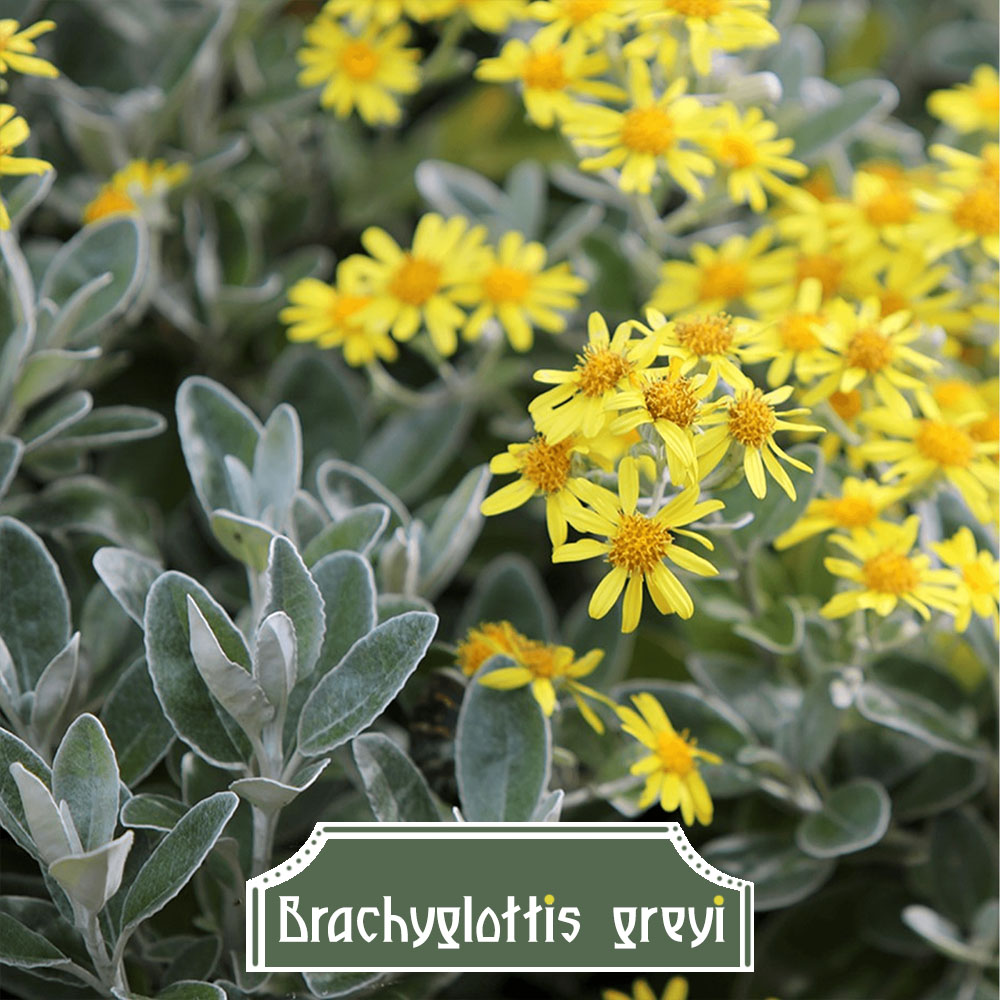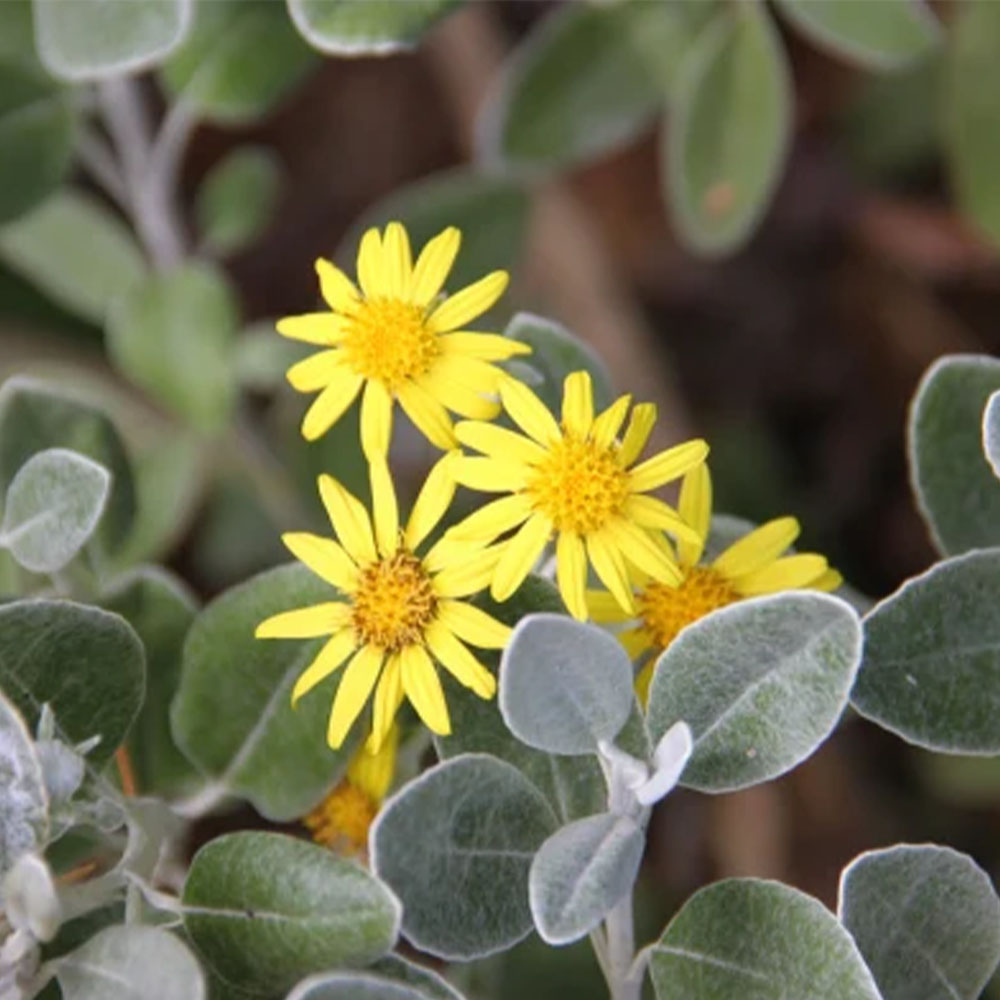No products in the cart.
Brachyglottis greyi
Soft grey velvety velvety bush covered in bright yellow daisy flowers
Rated 0 out of 5
0 customer reviews
4,90 € – 12,00 €Price range: 4,90 € through 12,00 €
Tags: bouquets, couleur, evergreen, feuillage persistant, graphique, Jardin Méditerranéen, longue floraison, Mediterranean, pepiniere lhoumois, secheresse, soleil, vivace, vivace en pot, xeriscaping
SKU: pda430
Category: Bees and Butterflies, Bouquet, Distillations, Evergreen, Frost Hardy, Rewild, The Stunners

Brachyglottis greyi
4,90 € – 12,00 €Price range: 4,90 € through 12,00 €
Brachyglottis greyi is primarily appreciated for its beautiful, velvety silver grey-green foliage, that is maintains even in the dead of winter, bringing softness to a landscape of brittle branches.
The leaves are dark green on top and much whiter underneath and are covered in fine white hairs. The extra graphic aspect is that each leaf has its own white outline.
The flowers are bright yellow and daisy-like.
The plant grows at a steady, fairly fast rate, mainly during rainy periods—typically in late summer and spring in mild climates.
👨🌾GARDENING TIP👨🌾:
-
- ✂️ Prune regularly to prevent the base from becoming bare, particularly in rich, moist soil > best time to prune is in October
- 💦 The flowering can last from June to October further north if the soil remains moist > mulching will help with this.
- 🫖 They are also easy to grow in large containers filled with well-draining soil (soil + sand + perlite will do the trick)
🌱🌿pdA Garden Buddy Suggestions🌱🌿 :
-
- For an all grey palette: Lavender, Helichrysum italicum, any of the Cistus, or Santolina
- For a color contrast: Salvia microphylla, Sedum Chocolate Cherry, Sedum Septemberglow
The Tales & The Botany:
The family is native to New Zealand, the wild species grows on cliffs and rocky outcrops, from the coast to inland river gorges in the southern part of the North Island.
This exposure has allowed them to develop a resistance to salty water, making them resistant to areas where the salinity in the air is particularly elevated.
Oceanic climate? Coastal terrace? Blistering summer heat? Brachyglottis will thrive.
It used to be classified in the family Senecio – due to the softness of its leaves? – but has found stability among the Brachyglottis.
🌸 Floral Morphology
Brachyglottis is a genus of shrubs and small perennials from New Zealand and nearby islands.
Most species produce corymbs or panicles of small, bright yellow, daisy-like flower heads. Each capitulum typically bears numerous golden ray florets surrounding a dense disk of tubular florets, all on slender peduncles.
Leaves are alternate, often elliptic to oblong, with a tomentose (silvery or felted) underside and a glossy green upper surface.
🌱 Reproductive Biology
Flowers are bisexual and predominantly protandrous, encouraging cross-pollination. Insects — especially bees and small flies — visit for nectar and pollen.
Seeds are small achenes with a pappus of fine hairs, aiding wind dispersal (anemochory).
🌍 Ecology & Adaptations
Native to coastal and montane habitats in New Zealand, Brachyglottis tolerates strong winds, poor soils, and salt spray.
The silvery undersides of the leaves reflect light and reduce water loss.
Several species exhibit rapid re-sprouting after cutting or grazing, an adaptation to disturbed environments.
Other Names:
Tree Senecio
Origin:
New Zealand
| Weight | 0,2 kg |
|---|---|
| Container Size | 9×9 cm, 2L |
| Flower Color | 🟡 Yellow |
| Flowering | July, August, September |
| Exposure | Full Sun |
| Frost Tolerance | -5°C to -10°C |
| Soil | Dry, Poor, Well-Draining, Rocky/Well-Draining |
| Size | 1.5m H x 1.5m W |
| Planting Season | March to May, September to November |
Reviews
0
Rated 0 out of 5
0 customer reviews
5
0
4
0
3
0
2
0
1
0
Only logged in customers who have purchased this product may leave a review.
You may also like…
Santolina chamaecyparissus
A fragrant, evergreyshrub with little yellow button flowers in summer
A fragrant, evergreyshrub with little yellow button flowers in summer
Rated 0 out of 5
Lavandula stoechas
A highly aromatic, velvet-leaved, drought resistant, flowering perennial.
A highly aromatic, velvet-leaved, drought resistant, flowering perennial.
Rated 0 out of 5
Cistus nigricans
A bush with dark green fragrant leaves that smell of summer
A bush with dark green fragrant leaves that smell of summer
Rated 0 out of 5
Helichrysum italicum
An evergrey, fragrant perennial that will bring a distinctly Mediterranean atmosphere.
An evergrey, fragrant perennial that will bring a distinctly Mediterranean atmosphere.
Rated 0 out of 5
Related Products
Erigeron kavinskianus
A daisy-like carpet of flowers
A daisy-like carpet of flowers
Rated 0 out of 5
Tanacetum densum subsp amani
A shrublet composed of soft, finely divided silvery gray-white leaves.
A shrublet composed of soft, finely divided silvery gray-white leaves.
Rated 0 out of 5
Tradescantia Blushing Bride
Gorgeous blushes of pink and white that appear in the coldest nights.
Gorgeous blushes of pink and white that appear in the coldest nights.
Rated 0 out of 5
Billbergia nutans
A bromeliad featuring a three colored, striped flower
A bromeliad featuring a three colored, striped flower
Rated 0 out of 5
Vinca minor
Looping elegance and ability to form a low flowering ground cover
Looping elegance and ability to form a low flowering ground cover
Rated 0 out of 5
Jacobaea maritima
A wooly white perennial plant from the Mediterranean region.
A wooly white perennial plant from the Mediterranean region.
Rated 0 out of 5
Delosperma cooperi
A dwarf perennial known for its vermillion colored flowers
A dwarf perennial known for its vermillion colored flowers
Rated 0 out of 5
Artemisia vulgaris Oriental Limelight
Striking green and yellow variegated foliage.
Striking green and yellow variegated foliage.
Rated 0 out of 5
Glechoma hederacea
A sweet smelling ground cover, producing little blue flowers all summer long.
A sweet smelling ground cover, producing little blue flowers all summer long.
Rated 0 out of 5
Sedum album
A low, multi-color ground cover.
A low, multi-color ground cover.
Rated 0 out of 5
Hieracium maculatum Leopard
A native perennial with blue-green leaves and a tall yellow flower
A native perennial with blue-green leaves and a tall yellow flower
Rated 0 out of 5
Euphorbia myrsinites
Known for its draping form of silver-gray foliage and radiant blooms.
Known for its draping form of silver-gray foliage and radiant blooms.
Rated 0 out of 5
Mentha x piperita ‘Chartreuse’
A spicy mint, known for its use in the production of liqueurs and herbal teas.
A spicy mint, known for its use in the production of liqueurs and herbal teas.
Rated 0 out of 5
Cerastium tomentosum var. columnae
A grey-green spreading ground cover from the mountains.
A grey-green spreading ground cover from the mountains.
Rated 0 out of 5
Artemisia alba subsp camphorata
A highly fragrant, grey-green bush.
A highly fragrant, grey-green bush.
Rated 0 out of 5
Achillea ptarmica Boule de Neige
White pompom flowers to attract bees to your garden all summer long.
White pompom flowers to attract bees to your garden all summer long.
Rated 0 out of 5
Solidago ‘Golden Shower’
Beautiful showers of yellow flowers
Beautiful showers of yellow flowers
Rated 0 out of 5
Echinops ritro
Tall, electric blue globe thistles
Tall, electric blue globe thistles
Rated 0 out of 5
recent view product
Sedum spurium Tricolor
A tricolored mat forming sedum
A tricolored mat forming sedum
Rated 0 out of 5
Lotus hirsutus
A semi-evergreen shrub with soft, silver-grey leaves that loves the sun
A semi-evergreen shrub with soft, silver-grey leaves that loves the sun
Rated 0 out of 5
Aster novi belgii Blue Pompon
Bright blue pompom flowers.
Bright blue pompom flowers.
Rated 0 out of 5
Tradescantia pallida var purpurea
A tender perennial known for its striking purple foliage.
A tender perennial known for its striking purple foliage.
Rated 0 out of 5
Centranthus ruber Roseus
A variation on the valerian theme – with soft pink flowers
A variation on the valerian theme – with soft pink flowers
Rated 0 out of 5
























































There are no reviews yet.